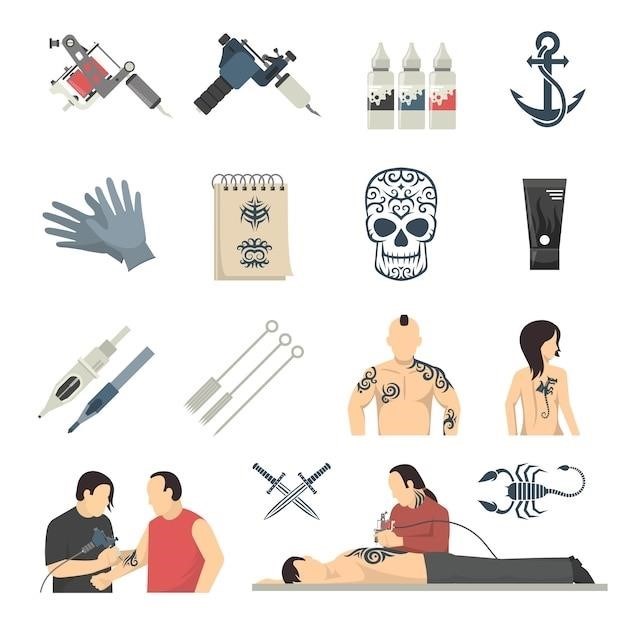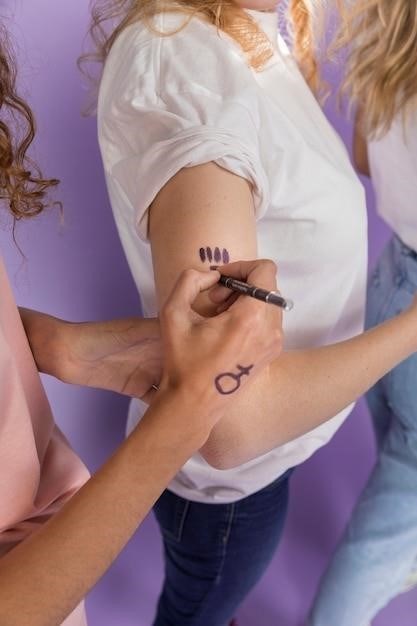Tattoo Placement Guide⁚ Finding the Perfect Spot
Choosing the ideal location for your tattoo is crucial. Consider factors like design size, visibility needs, and pain tolerance. Placement impacts both aesthetic appeal and daily practicality. Explore various body areas, from subtle small tattoos to large, statement pieces. Expert advice ensures your tattoo complements your lifestyle and personal style.
Choosing the Right Location for Your Tattoo

Selecting the perfect spot for your tattoo involves careful consideration of several key factors. First, assess the size and complexity of your chosen design. A large, intricate piece demands ample space, perhaps the back, chest, or thigh, while smaller, simpler designs are well-suited to wrists, ankles, or fingers. Think about the visibility of your tattoo. Do you want it to be easily seen or discreetly hidden? Highly visible areas like the face, neck, or hands make a bold statement, while less noticeable spots like the inner arm or ribcage offer more privacy. Your pain tolerance also plays a role. Some areas, such as the ribs, inner elbows, or ankles, are known to be more sensitive than others, such as the outer thighs or upper arms. Finally, consider the practicality of your chosen placement. Will it interfere with clothing or activities? A tattoo on the hand might be less suitable for certain professions. Weighing these factors carefully ensures you’re happy with your tattoo’s location for years to come.
Factors Influencing Tattoo Placement⁚ Size, Design, and Visibility

The ideal placement for your tattoo is significantly influenced by the interplay of size, design complexity, and desired visibility. Large-scale, intricate designs naturally require more expansive areas like the back, chest, or thigh to showcase their detail effectively. Conversely, smaller, simpler designs can be beautifully showcased on wrists, ankles, or even fingers. The visibility of your tattoo is another critical factor. Highly visible areas such as the face, neck, or hands project a bold, confident statement, demanding careful consideration of potential social or professional implications. Conversely, less visible areas such as the inner arm, ribcage, or lower back offer more discretion and privacy. The interplay between design aesthetics and desired visibility must be carefully balanced. Consider how the size and intricacy of your chosen design will be perceived in its chosen location, ensuring that the final result aligns with your expectations and personal preferences. Careful planning in this area will lead to a tattoo that you will love for years to come.
Pain Tolerance and Tattoo Placement⁚ Where it Hurts Less
Pain tolerance is a highly personal experience, varying greatly from individual to individual. However, certain body areas are generally considered less sensitive than others. Areas with more muscle and fat, such as the outer thighs, buttocks, and upper arms, tend to be less painful than areas with thinner skin and more nerve endings. Conversely, areas like the ribs, ankles, feet, and armpits are often cited as more sensitive, potentially causing more discomfort during the tattooing process. The bone proximity also plays a role; areas directly over bone, such as the wrists, elbows, and knees, can be more sensitive due to the lack of cushioning. While pain is subjective, understanding these general sensitivities can help you choose a placement area that aligns with your pain tolerance. Remember to communicate openly with your tattoo artist about your concerns; they can provide further guidance and recommendations based on your specific pain tolerance and chosen design. Preparation also plays a crucial role; proper hydration and rest can influence your body’s response to the procedure. Prioritizing comfort during the process will enhance your overall tattoo experience.
Aesthetic Considerations⁚ Enhancing Your Tattoo’s Appearance
The aesthetic impact of a tattoo is significantly influenced by its placement. Consider the natural curves and contours of your body. A flowing design might look best on a curved area like the upper arm or ribcage, while a geometric design might be better suited to a flatter surface like the forearm or shoulder. The size and shape of the tattoo should also be considered in relation to the body part. A large, intricate piece might overwhelm a small area like the wrist, while a small, delicate design might get lost on a large area like the back. Think about the visibility of the tattoo and how that might affect the overall aesthetic. A highly visible placement might demand a design that is both bold and striking, while a more concealed placement allows for more subtle and personal designs. Additionally, skin tone and texture can influence how the tattoo looks. Certain designs might pop more on lighter skin, while others might look better on darker skin. Consulting with a skilled tattoo artist is vital; they can help you choose a placement that will enhance the beauty and impact of your chosen design, ensuring the final result meets your aesthetic expectations and vision.
Practical Placement⁚ Considerations for Daily Life
Before committing to a tattoo, carefully consider its impact on your daily life. Highly visible placements, such as the face, neck, or hands, might affect professional opportunities or social interactions. Think about your workplace and whether visible tattoos are acceptable. Certain professions may require more discreet ink choices. Clothing preferences also play a role; a tattoo on a frequently covered area might limit design choices. Consider the potential for friction or chafing from clothing against the tattoo, especially during activities like exercise or manual labor. Some areas are more prone to sun exposure than others, affecting the tattoo’s longevity and color. Sun protection becomes vital for long-lasting vibrancy. Think about the healing process; easy-to-access areas might require more attention during healing, and some placements make aftercare more challenging. Practical considerations should guide your decision, ensuring your tattoo complements your lifestyle without causing inconvenience or regret. Prioritize long-term comfort and practicality alongside aesthetic desires.
Popular Tattoo Placement Areas⁚ A Comprehensive Overview
The human body offers a vast canvas for tattoo artistry, with certain areas consistently favored for their aesthetic appeal and practical considerations. Forearms and upper arms provide ample space for larger designs and are relatively easy to showcase or conceal. Shoulders and collarbones offer a visually striking location, often featuring intricate or smaller pieces. Rib cages provide a more intimate area, ideal for meaningful designs or personal statements. The back, with its expansive surface, is a prime choice for large-scale tattoos, often showcasing detailed or narrative art. Legs, particularly the thighs and calves, offer another significant area for larger pieces and allow for considerable creative freedom. Wrists and ankles are popular choices for smaller, delicate designs, often conveying subtle personal expressions. Hands and fingers are becoming increasingly popular, showcasing bold statements or intricate designs. The chest, a more intimate area, can host meaningful tattoos or works of art. Ultimately, the best placement depends on the individual’s preference, design, and personal style.
Large Tattoo Placement Ideas⁚ Back, Chest, and More
For those seeking expansive canvases for their large-scale tattoo designs, several prime locations offer both aesthetic appeal and practical considerations. The back, with its broad surface area, is a popular choice, allowing for intricate details and sweeping compositions. Large-scale back pieces often showcase narrative artworks, detailed landscapes, or majestic mythical creatures. The chest, another expansive area, provides a prominent location for bold statements or powerfully symbolic imagery. Consider the anatomical contours of the chest when selecting a design to ensure a harmonious blend of art and form. Outer thighs offer a less visible yet equally suitable area for large tattoos. Their ample space accommodates detailed designs or flowing patterns. Upper arms, while slightly smaller than backs and chests, still offer sufficient room for impressive displays of artistry. When placing large tattoos, careful consideration of the design’s placement and orientation is crucial. The chosen location should complement the overall aesthetic and allow for comfortable movement and daily life. Always consult with your artist to ensure the design’s scale and placement suit your body and lifestyle.
Small Tattoo Placement Ideas⁚ Subtle and Stylish Options
For those seeking understated elegance, small tattoos offer a discreet yet impactful way to express individuality. Delicate designs, such as minimalist line art, tiny symbols, or short, meaningful quotes, are perfectly suited for smaller spaces. The wrist, with its gentle curve and proximity to the hand, is a popular choice. Small tattoos on the wrist are easily visible but can be concealed with long sleeves. The fingers, offering a unique and playful canvas, allow for individual expression through tiny designs. The ankle, a more hidden yet visually interesting spot, offers space for small, intricate details. Behind the ear, a subtle and often overlooked area, is ideal for small designs easily concealed by hair. The inner forearm, a less visible yet still accessible area, provides a space for personal, meaningful designs. Necklines, particularly just below the collarbone, can subtly showcase small, delicate pieces. When choosing a placement for a small tattoo, careful consideration of the design’s scale and style is essential. The tattoo should not only complement the chosen area but also enhance its aesthetic appeal. Consult with your artist to ensure the design is both visually appealing and suited to the chosen location.
Tattoo Placement and Professional Considerations⁚ Job Interviews and Visibility
Before committing to a tattoo, especially a large or highly visible one, carefully consider its potential impact on your professional life. Certain industries maintain stricter dress codes and may view visible tattoos negatively, potentially hindering career advancement. If your job requires frequent interaction with clients or involves a formal business setting, strategically placing your tattoo in a less visible area could be beneficial. Areas like the inner thighs, lower back, or upper chest allow for personal expression without compromising a professional image. However, even discreet placements might require careful consideration. If you’re uncertain about your workplace’s policies, discreetly inquire with HR or your supervisor before getting a tattoo. Remember that body art is a personal choice, but its visibility can significantly influence professional perceptions. Weigh the pros and cons carefully, considering your career aspirations and the potential implications of visible ink. Ultimately, the decision rests on balancing self-expression with professional expectations. This thoughtful approach ensures your tattoo enhances your life without negatively impacting your career trajectory.
Aftercare and Placement⁚ Factors to Consider for Healing
Tattoo placement significantly influences the healing process and aftercare. Areas with constant friction, like the hands, feet, or ankles, require extra attention during healing. These locations experience more rubbing against clothing and other surfaces, potentially disrupting the healing skin and increasing the risk of infection or scabbing. Similarly, tattoos on joints, which bend and stretch frequently, are more prone to cracking and fading. Conversely, tattoos on less mobile areas, like the upper back or outer thighs, generally heal more smoothly with minimal disruption. Regardless of placement, meticulous aftercare is crucial. This includes diligent cleaning, moisturizing, and protecting the tattoo from the sun. Avoid swimming, strenuous exercise, and tight clothing, especially during the initial healing phase. Following your artist’s aftercare instructions is paramount for optimal healing and long-term tattoo vibrancy. Remember, proper aftercare minimizes complications, regardless of the tattoo’s location, contributing to a beautiful and lasting result. Consult with your artist for specific advice regarding your chosen placement and aftercare needs.



